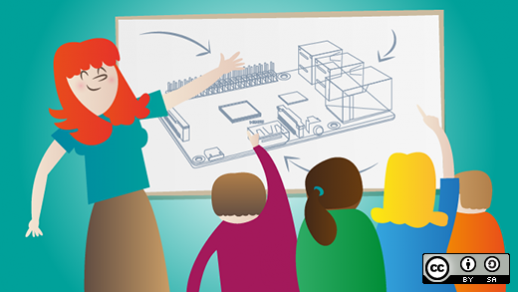I recently finished reading Your Starter Guide to Maker Spaces by Nick Provenzano, a Raspberry Pi Certified Educator. In the book, Nick describes a Raspberry Pi competition at the school where he teaches.
Each student received a Raspberry Pi kit and was told to identify a problem, come up with a solution using the Pi, and not spend more than $75 on their project. The students' solutions varied, but the common result was that the students taught themselves to code. This is what happens when you give students a broad assignment and ample opportunity to explore learning on their own.
If you're a teacher who wants to incorporate this type of learning for your students, the Raspberry Pi can be the platform that facilitates that experience, and Opensource.com has a wealth of resources to help you make it a reality in your classroom.
First, select the right Raspberry Pi
Wondering which Raspberry Pi is right for your classroom? Raspberry Pi Community Manager Ben Nuttall is here to help.
- Ben's step-by-step guide to getting started with the Raspberry Pi describes most of the available Raspberry Pi models and the other hardware you'll need, like a mouse, keyboard, and monitor.
- In another article, he offers suggestions on which Raspberry Pi is best for which type of project.
- If you want to learn more about the newest member of the Raspberry Pi family, read Ben's introduction of the Pi Zero W, which adds built-in WiFi and Bluetooth. Also, check out Anderson Silva's review.
1. Learn to program with Raspberry Pi
Once you've invested in a Raspberry Pi, you're probably wondering what you can do with it. Its standard operating system is Raspbian Pixel, which is based on Debian Linux and specifically compiled to run on the Raspberry Pi.
After your first boot, you can explore the desktop and menu options. You'll see "Programming" at the top of the menu; there are a number of choices, but my favorites are Scratch and Python 3. I recently taught a group of students to animate using Scratch and to create Turtle graphics using Python.
Bryson Payne's book Teach Your Kids to Code (which I reviewed) is a great place to start learning to code. In no time, you'll have your students programming and making beautiful graphics using Python with the Raspberry Pi. Raspbian Pixel also includes other programming environments including Java, Sonic Pi, and the Sense HAT emulator.
2. Get busy with software
Raspberry Pi works quite well as a standalone computer using the applications that come with it.
- The LibreOffice suite of applications includes a word processor, database, spreadsheet, and presentation software that you and your students can use for things like writing, calculating, and presenting.
- The Raspberry Pi 3 comes with the Chromium browser for easy access to the internet.
- Raspbian Pixel also includes Minecraft Pi, a special build of the popular game.
In addition, Raspbian has hundreds of other programs that can be installed without cost, since the software is free and open source.
3. Do a project
Suppose that you and your students really want to get your feet wet with a do-it-yourself project to test the utility of this platform.
- An eBook server is one of the easiest beginner projects. With my step-by-step guide, in no time you and your students will be downloading and sharing free books from Project Gutenberg and other open educational resources.
- Build a Raspberry Pi powered dashboard to display weather, bus schedules, news headlines, and more with this how-to from Conor O'Callaghan.
- If you are in a broadband-deprived area or just want to lock your content server safely behind your own firewall, build an Internet-in-a-Box that serves educational content from Khan Academy, TED Talks, Wikipedia for Schools, Open Street Map, and more.
4. Practice on your PC
If you want to take a peek at this exciting technology and you can't wait for your new Raspberry Pi kit to arrive, download Raspbian Pixel on a PC. It is available in ISO format and can run on x86 processors. That means you can run it on older hardware that's just sitting around collecting dust, or you can install it in a virtual machine in VirtualBox. You can learn how to do this in an article Ben Nuttall wrote earlier this year.
5. Host a meetup
Finally, once you have ignited a firestorm of enthusiasm at your school, you may want to host a Raspberry Jam, aka a Raspberry Pi meetup. As Ben Nuttall wrote, Jams "come in many different formats. Some are like traditional tech user groups, but many are family-friendly events that provide opportunities for kids to learn to code and make things."
What are you most interested in knowing about Raspberry Pi? And, if you're already a Pi user, what do you think are the most important things for educators to know about it? Please share your thoughts in the comments.







5 Comments